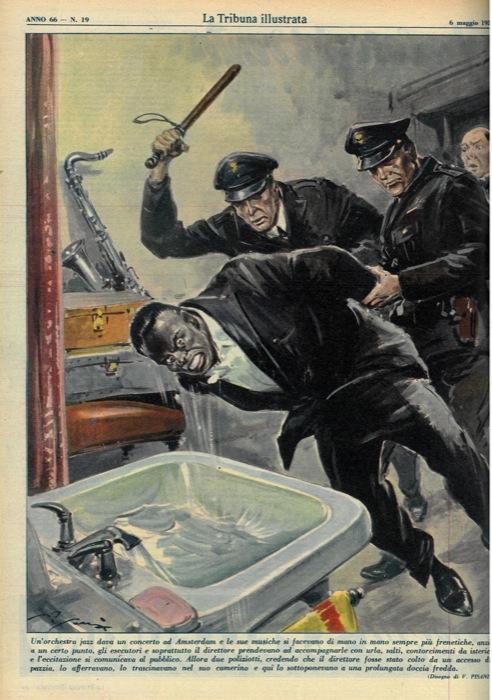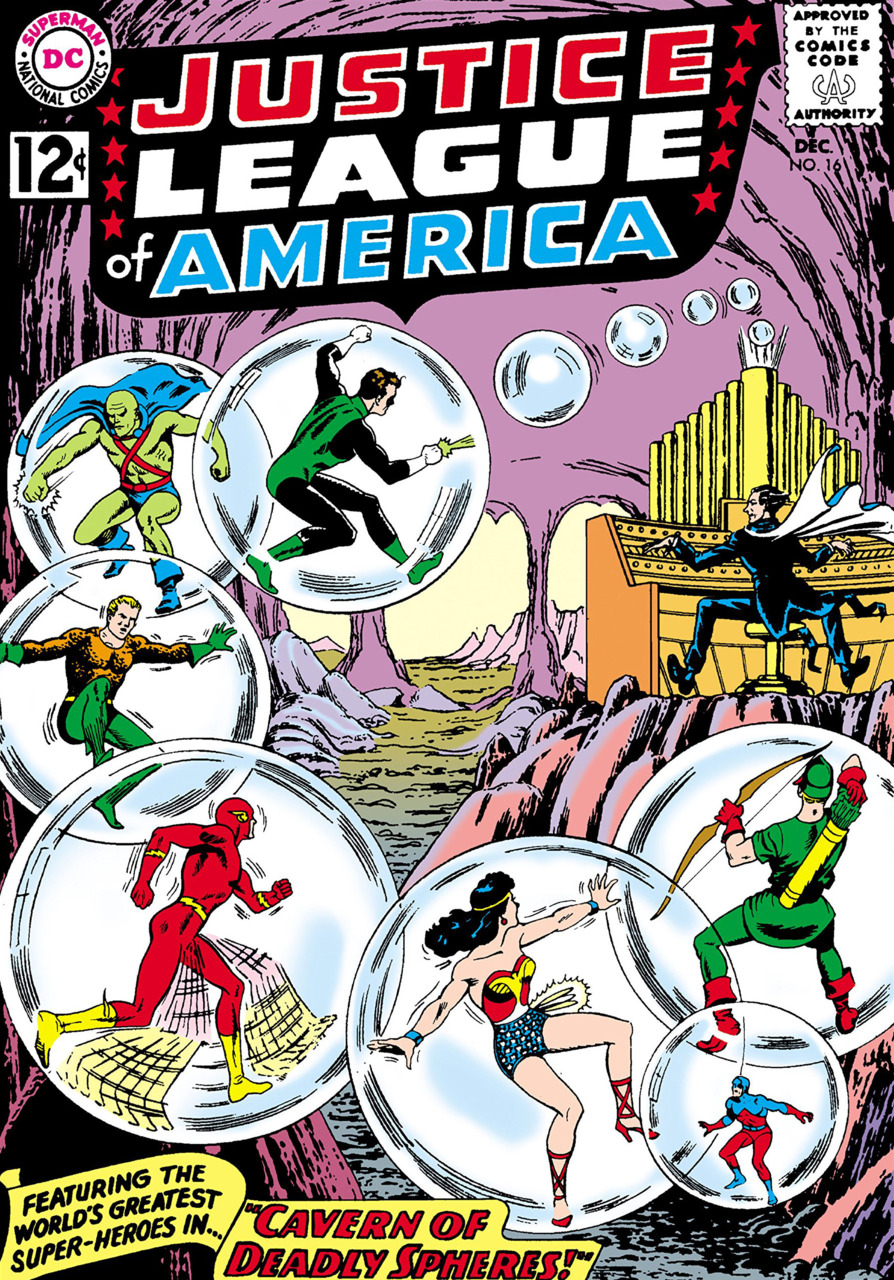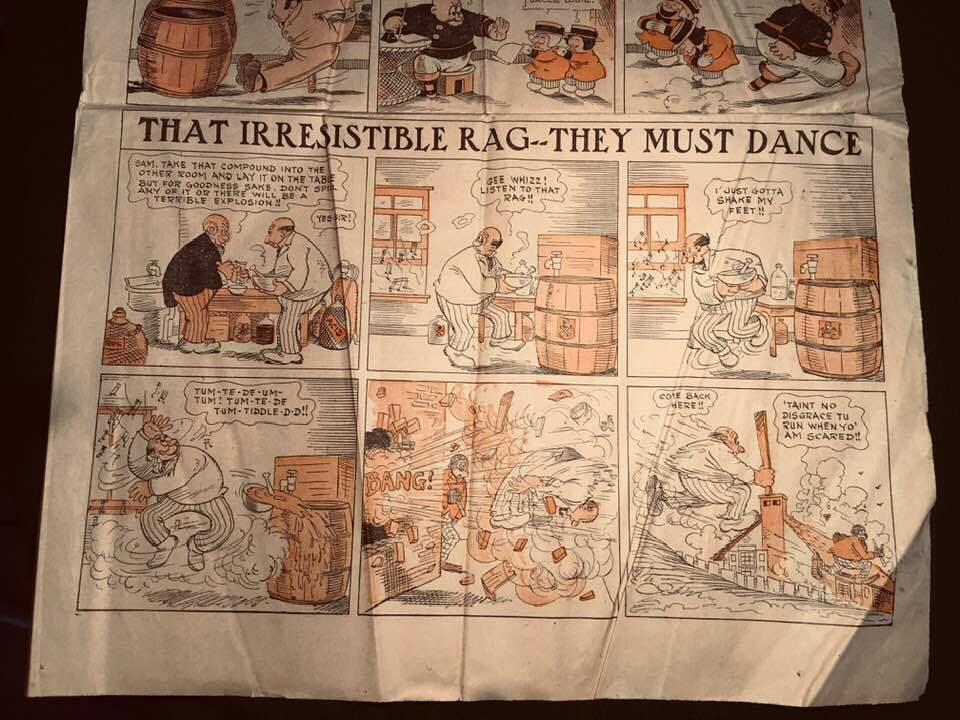|
Music Is The Healing Force Of The Universe The Inconsistency of |
|
|
|
From Il Manifesto (31 August, 2019) A pdf of the original Italian version is available here.
ALIAS The rhythm of possession Stories / For decades jazz has been associated with madness and mental alterations. A music burdened by stereotypes that have thickened essays and comics often dominated by the account of the psychological discomforts of the artists. In 1913 a US comic tells the adventures of an African-American flutist whose ragtime unleashes insane dances. In 2007 Albert Ayler takes us out of the body |
 |
|||
|
An illustration that appeared in 1956 in La Tribuna Illustrata tells the story of a jazz orchestra in Amsterdam whose performers accompanied the music “with shouts, jumps, hysteria contortions and excitement communicated to the public. Then two policemen, believing that the conductor of the orchestra had been seized by an access of madness, seized him, dragged him into his dressing room and here subjected him to a prolonged cold shower “
Flavio Massarutto EDITION OF
One of the essential components in the formation of the collective imagination of the Italians were the covers of the illustrated magazines: La Tribuna Illustrata starting from 1890 and then Domenica del Corriere from 1899 brought the current events to the houses of the Belpaese. A color image created by great designers including Achille Beltrame and Walter Molino with a short caption occupied the first and fourth cover. Thanks to those illustrations, the Italians were catapulted into exotic worlds, in the midst of fighting, in the ceremonies of the nobility and in the sordid environments of the underworld. With the passage of time and in particular after the war the settings concentrated on sensationalist news stories, catastrophes, bizarre news and curiosity. The vagueness of the captions meant that, more than real journalism, the images are based on urban legends. Precisely for this reason they constitute a reliable sample of custom and common sense. In an illustration that appeared in 1956 in La Tribuna Illustrata, the reader learns that "a jazz orchestra gave a concert in Amsterdam and his music became increasingly frantic and even at some point, the performers and especially the conductor took to accompany them with screams, jumps, contortions from hysteria and excitement was communicated to the public. Then two policemen, believing that the director had been seized by a madness, grabbed him, dragged him into his dressing room and here they subjected him to a prolonged cold shower ". Vittorio Pisani's drawing portrays the musician with his hallucinated gaze and his crazy expression while the policemen force him to the sink by waving a truncheon. This image, which today we can afford to look at with a smile and a slight discomfort, actually says a lot about the current opinion, much more rooted than we think, which establishes a link between jazz and the phenomena of possession, of the states of altered consciousness and madness.
FATAL ATTRACTION Since its appearance, African American music has aroused feelings of hostility or attraction largely derived from this opinion. Not only the right-thinking and bigots of all latitudes saw the danger of breaking into the orderly Western society of “savage practices” but also many intellectuals, progressive and otherwise, have exalted its alleged primitivistic qualities. Of course jazz is not at all a primitive music but a product of modern society, indeed modern music par excellence, the best expression of the diasporic condition, be it social or existential. But the prejudice is hard to die and still influences the discourse on jazz. The complex relationships between music and the phenomena of possession have been well explained by the ethnomusicologist Gilbert Rouget in his Music and Trance, recently reissued by Einaudi, but the widespread opinion that certain types of music induce, regardless of cultural context and social practices, in those who listen to them forms of possession continues to remain fascinating. One of the obsessions of modern society is that relating to the body. The body must be controlled and disciplined. A body that does not subject itself to the needs of production and surrenders itself to expenditure is a dangerous body. The dance, the sexual activity, the game as activities that can take time and energy from work are subject to regulations that have the task of regulating their intensity, frequency, spaces of action. The fear that, not properly delimited, invade the production space is widespread and generally shared. One of the most important features of African-American music is the rhythmic component that is immediately kinetic and one of the reasons for its immediate and pervasive success lies precisely in being so stimulating as to be contagious. Harold Hering Knerr's (1882-1949) cartoon That Irresistible Rag, which appeared for the first time in US newspapers in 1913, features an African-American tramp. Whenever he starts playing a ragtime motif with his flute, anyone in the vicinity, be it human or animal, is immediately caught by the frenzy of the dance, creating comic situations whose effects come down on the musician. It must be said that it is not always a matter of misfortune because if it is true that often the poor vagabond remedies a lot of sticks, sometimes he gets rewards or the coveted meal. The general tone of the stories, composed of six vignettes of equal size, is light and amused. Music is more of an opportunity than a threat. Like many comics of the period he is more subversive than what you seem at first sight. As evidence of the success of this comics, the composer Fay Parker wrote ragtime That Irresistible Rag in 1914 (you can hear it on the pianist Nora Hulse’s Cake Walks, Two Steps and Rags by Women Composers).
SUPER HEROES Taking a leap of fifty years we arrive at 1962 when the episode The Cavern of Deadly Spheres appears from the series Justice League of America where Atom, Aquaman, Batman, Flash, Green Arrow, Green Lantern, J'onn J'onzz, Snapper Carr, Superman and Wonder Woman work in the team. In that story they have to deal with the Master, the bad guy who, spreading his music through speakers, forces everyone to dance without being able to stop. Citizens, law enforcement officers and executioners in tights are rendered helpless by possession and cannot oppose the robbery of the Master. We thus have the opportunity to see the superheroes captured by steps of jig or by the dance of whirling dervishes. On a boat the music is played by a quartet of jazz musicians and Flash is kidnapped by Buck and Wig, the forerunner dance of tap dance spread through vaudeville and minstrel shows. But when our superheroes go to capture the Bad in the cave where they have taken refuge, properly fitted with ear plugs, they will have to find out that they have been deceived. To induce the wild dance was a bundle of high-frequency rays that act on the motor centers of the brain and the music was just a cover to attract superheroes into the trap. In short: it is better not to trust appearances even when it is a juxtaposition that would seem as obvious as that between music and possession.
MANGA We have all experienced how a particularly concentrated listening can act deeply on our emotions. In general, with or without taking drugs, music has the power to make us feel emotions and in some cases to open up our perception towards new and surprising sensations. Listening to music is a good act of ecology of the mind because it leads us to imagine the other from ourselves. Listening to music, we have the impression of entering higher levels of understanding and experiencing parts of our mind that are unknown to us. The relationship, therefore, between music and altered states of consciousness is strong and the suggestions it elicits are resistant to time and fashion. Based on this idea is the Astral Project manga written by Marginal and designed by Syuji Takeya released in Japan between 2005 and 2007 and translated into Italian by Jpop. The protagonist of the comic discovers that listening to a CD with an unpublished recording of the saxophonist Albert Ayler he experiences an extracorporal journey. The boy breaks away from his body and flies into the sky of the city where he will make incredible encounters. The story is long and complex and it is not worthwhile here to tell it in its entirety except to emphasize how jazz is told as a device capable of activating unexpressed potential. The choice of Albert Ayler is significant as a leading exponent of that trend of free jazz that focuses heavily on the Dionysian and sensual element. Albert Ayler also has a perfect biographical story as he committed suicide following serious mental problems. In the comic we read that: “One day in November 1970 (...) the same day that writer Yukio Mishima performed ritual suicide in the headquarters of the self-defense forces of Ichigaya (...) Ayler’s body was found in New York, in the East River (...) were they superior minds? Or fools? Needless to ask ... both had crossed a border ...”. The fortune of the myth that wants inextricably linked genius and recklessness knows no slowdown. If then the unruliness borders on madness the myth becomes stronger. It would be enough to look at today’s invasion of books, films and comics on the painter Vincent Van Gogh. in the East River (...) were they superior minds? Or fools? Needless to ask ... both had crossed a border ... ». The fortune of the myth that wants inextricably linked genius and recklessness knows no slowdown. If then the unruliness borders on madness the myth becomes stronger. It would be enough to look at today's invasion of books, films and comics on the painter Vincent Van Gogh. In jazz there are many biographies of his greatest heroes to be studded with psychiatric problems. Social conditions of racism and marginalization, immoderate use of alcohol and drugs, have undoubtedly facilitated the emergence of such problems. And the mythology of jazz has been imbued with it. All the jazz fans know the famous version of Lover Man engraved on the brink of psycho-physical collapse by Charlie Parker and that is invariably cited in every work that regards him as, for example, the comic biography Charlie Parker. Before jazz was danceable then it was «bird» by Angelo Leonardi and Gaspare and Gaetano Cassaro (Ottaviano, 1980). Bud Powell, Charles Mingus and Thelonious Monk also suffered serious psychological problems and hospitalization in psychiatric institutions. On the latter, a magnificent graphic novel has just been released, Monk! Thelonious, Pannonica, and the Friendship Behind a Musical Revolution (First Second, 2018) written and designed by Youssef Daoudi who retraces his life by crossing it with that of his friend Pannonica de Koenigswarter without reticence or silly myths of his problems.
LEGEND But the figure that most of all is, not only crossed, but literally contained in the context of madness is that of the cornettist Buddy Bolden. Born in New Orleans in 1877, already in 1895 he was at the head of his own band. He is said to have had such a powerful sound that “he could be heard twenty kilometers away, on starry nights.” His legend has been built over time thanks to the oral testimony of musicians such as Bunk Johnson and Jelly Roll Morton, the latter, as written on Alias last August 24th, now finally available to the Italian public thanks to the Quodlibet publishing house that translated Mister Jelly Roll. Life, fortunes and misadventures of Jelly Roll Morton, Creole of New Orleans, “Inventor of Jazz” of ethnomusicolgist Alan Lomax. Inaccuracies and gaps in those stories have been corrected by the precise historical research of Donald Marquis that In Search of Buddy Bolden has reconstructed the story drawing on unpublished documents. We know that he was one of the most important figures in the transition from the set of music that was played in New Orleans to jazz. Use of blue notes, vocalization of the instrument, accentuation of syncopations; in a nutshell a pioneer of jazz improvisation. According to Morton he was “a boy with not too dark skin and he came from Uptown. He drank all the whiskey he could find, he never wore a collar and a tie, he kept his shirt open so that all the girls could see his red flannel tank top, he was always around having fun. Buddy Bolden was the most powerful trumpet player in history (...) He was the most energetic “blower” after the archangel Gabriel”. Bolden performed in the infamous clubs, parks and street parades. Right after one of these parades, on the occasion of Labor Day, in 1907 the Louisiana State Asylum for the Insane in Jackson collapsed and was hospitalized in a mental hospital, where he lived until his death in 1931. The record of hospitalization notes that Bolden was “destitute, dirty, inconclusive and registered as a laborer”. A portrait of him and a photo of his band remain of him. His music has never been recorded. The exiguity, if not the total lack of documents, has fed, as always happens in these cases, its legend. The novel Buddy Bolden’s Blues (1976) by Canadian writer Michael Ondaatje has extended its fame to the general public. The main suggestion in the novel comes from what Jelly Roll Morton told Alan Lomax, that is, that Bolden had gone mad by blowing into the trumpet. The idea that a musician goes mad due to such total dedication to his art to be fatal to him is far more interesting than that of a decline due to prolonged alcoholism. The very story of that last parade is the Let that Bad Air out comic book. Buddy Bolden’s Last Parade (The Porcupine’s Quill, 2007) by Canadian designer Stefan Berg. Made with the technique of engraving and without text, the book tells in seventy tables the parade through the streets of New Orleans until the crisis and the fall. The particular technique used emphasizes the drama of the story as well as evoking the historical period. Berg in fact refers to the books of the Belgian Frans Masereel, published in Europe after the First World War, with a strong anti-bourgeois and pacifist social and political content, considered as precursors of the graphic novel for how they used storytelling in images dealing with realistic themes. CATATONIC We conclude this overview with a brief history of the designer Ron Regé Jr., exponent of the neo-psychedelic comic strip. The cartoonist has dedicated some short stories of a table to Sun Ra. The composer, pianist and bandleader, one of the greatest exponents of free jazz, is today a cult object, based largely on the image (which he has cleverly constructed) of a bizarre musician whose music would be crazy, in the sense of completely free from constraints and conventions. Madness as a way out of conformism. In Sun Ra’s “Advice for Medics” (The Cartoon Utopia, Phantagraphics Books, 2012) an episode of the biography of the musician is told. Sun Ra is invited to play at a music therapy session in a Chicago psychiatric clinic. The public is composed of catatonics and schizophrenics. Of course he plays his usual music. At that point a woman, who had never spoken or moved for years, gets up and addresses him screaming “but you call this music?” Clearer than that. __________
A full synopsis of Justice League of America #16 ‘Cavern of the Deadly Spheres!’ is available at Comic Vine. |
|||
 |
|
And here’s ‘That Irresistible Rag’ from the Sunday comic section of The Times-Picayune of New Orleans, Louisiana, of 22nd August, 1915. |
 |
|
Back to What’s New - October 2019
|
||
|
Home Biography Discography The Music Archives Links What’s New Site Search
|
||
